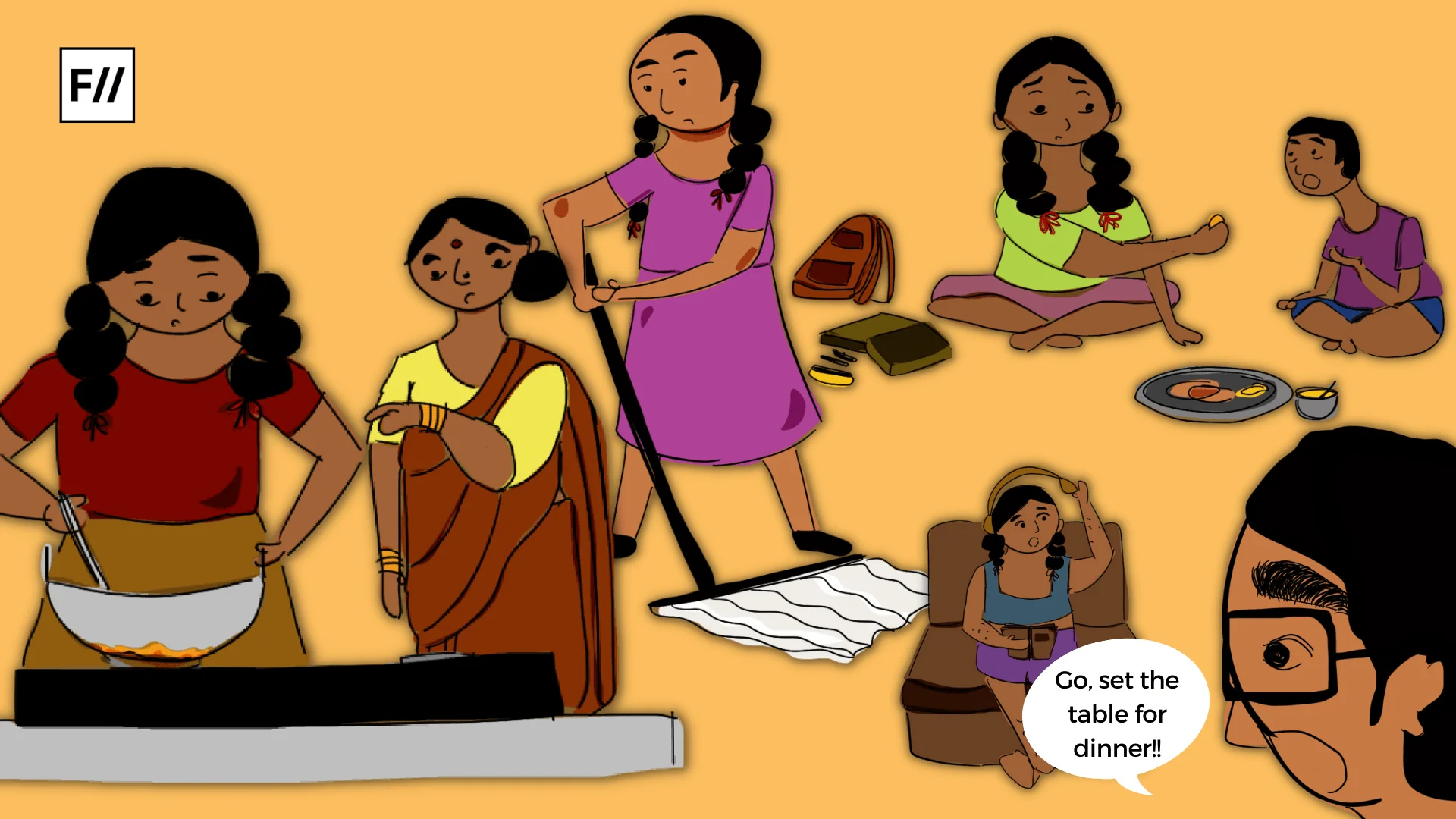In November 2020, 2% fewer men but 13% fewer women were employed or looking for jobs, than a year ago. Owing to the COVID-19 pandemic, women are facing massive job and income losses. Between March and April 2020, 15.4 million women lost their jobs, or 37% of the female workforce, versus 28% of men. Between May and August 2020, the urban female unemployment rate stood at 21.9% compared to 11.7% for urban males.
Even the women who have not lost their jobs, lost their pay during the pandemic – an estimated 7.4 crore women in the informal economy globally saw a 60% loss in their income within the first month of the pandemic. A UN Women report estimated that 4.7 crore women and girls have been pushed into extreme poverty. In a country like India, the impact has been worse on marginalised communities. For instance, domestic workers, most of whom are migrant women belonging to Dalit, Bahujan and Adivasi communities faced severe impact: job losses, lack of pay and an inability to return to work after the restrictions were lifted because of the lack of access to safe (private) transportation.
Also read: Victims Of Abuse & Their Dynamics With Space
Domestic workers, most of whom are migrant women belonging to Dalit, Bahujan and Adivasi communities faced severe impact: job losses, lack of pay and an inability to return to work after the restrictions were lifted because of factors including the lack of access to safe (private) transportation.
It is well known globally and within India that women get rationed out of better jobs and out of all jobs when jobs become scarce. Getting women into the workforce would be key to the recovery of the country. Getting even 50% of Indian women into paid work could boost GDP by 1.5 percentage points per year. Recognising this, the government and its partners promised several social protection measures, notably – direct cash transfers, free grains (such as rice), free gas cylinders, and an increase of collateral-free lending limits (to benefit women’s self help groups). However, an extremely important aspect that the government did not address and we (as the civil society) have not focused on is women’s mobility, especially in cities.
Urban Women’s mobility
“Transportation is the fulcrum that allows women to participate in the workforce” said Sonal Shah, urban transport and gender expert. While it has already been established that women and men travel differently, these differences in travel patterns, combined with existing and new fears of women being outside their homes have disproportionately impacted women. Even before COVID-19, only 54% of women were allowed to go to a nearby market alone and only 48% could visit places outside their village or community by themselves. With COVID-19, women now require “justifiable” reasons to leave home, inhibiting their ability to work, run businesses, study, or even avail health care services and government aid.

Clement Chauvet, chief of skills and business development at UNDP said “There are two key factors that determine a woman’s decision to seek a job: safety and mobility. “She asks: ‘How will I get to work?’ And ‘can I come and go safely.‘” On the other hand, women’s increased physical mobility results “in economic mobility and improved access of economic opportunities, thereby enhancing sources of livelihood.”, said Ritu Dewan, economist and director, Centre for Development Research and Action.
Safe, comfortable, convenient and affordable transport can play an important role in not only helping meet women’s practical needs such as access to schools and markets, but also in contributing to their strategic empowerment by facilitating access to social and economic opportunities. It has to be noted that these concerns and analysis still focus on able-bodied women. An in-depth study on the impacts of COVID on women with disabilities has been conducted by Rising Flame and has been documented at length on Feminism in India.
To understand the impact of the COVID-19 lockdown on urban women’s mobility, I interviewed some of the country’s experts in the spaces of gender, urban development, livelihoods and transportation, such as Firoza Suresh, bi-cycle mayor of Bombay; Dr. Karen Coehlo, assistant professor at Madras Institute of Development Studies; Kalpana Viswanath, founder of Safetipin; Meghna Chaudhury, co-founder of We Unlearn; Nandita Baruah, India country representative of the Asia Foundation; and Tara Krishnaswamy, founder of Political Shakti and Citizens for Bengaluru.
Also read: State And Surveillance In Urban Spaces For ‘Protecting’ Women In Distress
Impact of the lockdown on women’s mobility
The lockdown has restricted the mobility of all city dwellers, but it has restricted women’s mobility the most. While the restrictions on men’s mobility might be lifted as soon as the pandemic is brought under control, women’s mobility will not simply bounce back to its earlier state because the impacts have been multifold:
Safety
Kalpana Viswanath said “One of the key elements of safety is the presence of an active street life.” In a pandemic scenario, it was necessary to ask people to stay indoors, but if streets continue to be deserted, women’s safety will be severely compromised. A factory worker in Chennai once pointed out to me that if she could choose between two buses, one that is empty with mostly men and one that is crowded with mostly women, she would choose the crowded bus because, “Even if I am uncomfortable, I will be safe.” The situation will only get worse in the future if fewer women get back into the public space.
Care work
Viswanath also said that “Domestic responsibilities of women and the expectations from them grew manifold, therefore their mobility is impacted because of care work.” While a strong argument should be made for care work being a shared responsibility between men and women, the reality of our society is that women are responsible for taking care of the ‘home’. Before the pandemic, women were spending nearly five hours in unpaid domestic work at home compared to just over an hour-and-a-half for men. In such a situation, Nandita Baruah asks “If we can’t open schools and creches, how will women go back to work? They will have to choose between child care and work” and most of the time, this choice is not in women’s hands.
Public transport
“Freezing of public transport (PT) reflects powerful class and gender bias,” said Dr. Coehlo. Most women depend on buses and local trains for their daily commute. Public transport also includes informal modes such as shared-autos. “IPT (informal public transport) is a huge livelihood opportunity and is an aspect of a self-built city,” said Dr. Coehlo. IPT is a crucial mode of transportation in cities that don’t have a formal public transport system and acts as a mode for last mile connectivity where such systems exist.
Women could not get to their places of work and ended up losing jobs during the pandemic owing to lack of public transport. Even after the unlockdown began, public transport was not immediately restored, keeping women away from their workspaces.
Baruah explained that “Men who had their own vehicles could join some gig-economies and redefine their work, but women were not able to do that.” Meghna Chaudhury added that “property is generally owned by men in India and so, women do not own private vehicles.” Many domestic workers in the city of Hyderabad, for example, were asked not to come back to work if they were using buses, trains or shared autos – this increased their dependence on the men in the family for transportation. Dr. Coehlo points out that “Autonomy is linked to mobility and women have to be autonomous from family or other women to travel” and that the lack of autonomy that emerged as a result of the pandemic will impact women’s access to work, education and leisure.
Tara Krishnaswamy critiques that “CSOs pressured governments into cashless transactions and use of apps for booking tickets. We have to remember that the penetration of smartphones in the country is limited and most smart phones are owned by men. There is inequity in data access on top of that.” The new focus on digital ticketing is highly problematic because, in India, 63% of adult women own a mobile phone (compared to 79% of adult men), but only 21% use mobile internet (compared to 42% of adult men).
Krishnaswamy points out that “If buses don’t cater to women, women would have no other way of getting to work.”
Cost
The cost of transportation has to include the financial component and the time component. Within a family, women are poorer than men because they have lesser access to financial resources – this means that they use cheaper modes of transportation that are inevitably slower. Women also face time-poverty and have to constantly make choices between going outside the house and managing their domestic work burden.
In the aftermath of the first wave of the pandemic, buses and trains were the last to be made functional, and even then, they were to run at lower capacity and higher cost. Even before the pandemic, studies found that the cost of public transport was prohibitive for women.
In the aftermath of the first wave of the pandemic, buses and trains were the last to be made functional, and even then, they were to run at lower capacity and higher cost. Even before the pandemic, studies found that the cost of public transport was prohibitive for women. Tara Krishnaswamy, while talking about the buses in Bangalore after the lockdown, pointed out that “BMTC buses said only passes, no cash transactions. Women’s daily expense on travel is 30-40 rupees while the daily pass costs 70 rupees. Even a weekly pass is very expensive for women.”
Krishnaswamy also comments about time poverty, saying that “lower frequency means longer waiting time which women cannot afford – because they have to get home at a certain time.” Baruah highlights that, “The higher cost (money and time) of transportation can mean the difference between getting back to work or having to stay at home.”
However, the battle is not lost. These experts also suggested ways in which these negative impacts can be mitigated or at least, reduced. The second article in this two-part series will focus on mitigation strategies.
Aila Bandagi is an urban researcher and activist. Her work focuses on gender and cities in India. She is an India Urban Fellow from IIHS, Bangalore; A Writing Urban India Fellow from CPR, Delhi; and holds a master’s degree in development studies from TISS, Hyderabad. She previously worked as a fact-checker with Factly and as a research associate for inclusive development with the Institute for Transportation and Development Policy (ITDP). She is currently a PhD scholar at the department of geography, University of Nevada and is trying to define what a gender responsive city in the global south means. You can find her on Instagram and reach out to her on email here: aila@nevada.unr.edu
Featured image source: National Geographic




